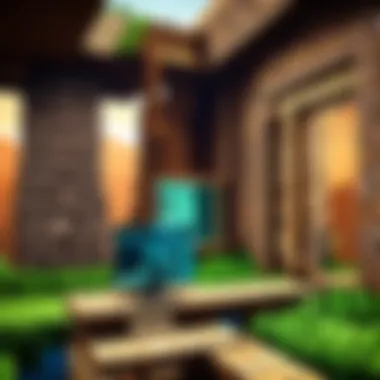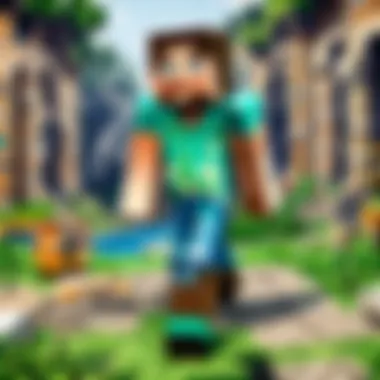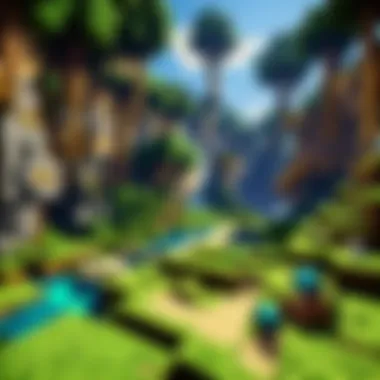Understanding the Pricing Structure of Minecraft on PC


Intro
Given the expansive nature of Minecraft, it is essential for potential buyers to grasp the nuances behind these pricing models. Every edition tells a story, and every cost has its rationale. In this piece, we'll also touch on how Minecraft stacks up against its competitors on different platforms. Understanding historical pricing shifts adds another layer to our exploration, revealing why past decisions can inform future purchases. Finally, we will provide thoughts on which demographics might see the best returns on investment — an aspect often overlooked in gaming discussions.
Let’s dive in and navigate the intricate waters of Minecraft’s pricing on PC, pulling back the curtain on what you really need to consider before making a purchase.
Preface to Minecraft Pricing
Overview of Minecraft
Minecraft is not just a game; it's a phenomenon that has captured the hearts of millions worldwide. Released in its alpha form back in 2009 and officially launched in 2011, this sandbox game allows players to build, explore, and create within a limitless world. You start with the basics: gathering materials, crafting tools, and building shelters to survive the night against various threats. Over time, it has evolved into a versatile universe that accommodates various play styles, from survival mode to creative mode, where imagination knows no bounds.
The game is available in several editions that cater to different preferences and players across various platforms. This variety adds another dimension to its pricing and value. Whether you are a casual player or someone who dives deep into the mechanics and modding, understanding these nuances is essential.
Significance of Pricing in Game Market
Pricing in the gaming market serves as a direct reflection of various factors at play, from development costs to marketing strategies. In the case of Minecraft, its pricing structures can illustrate how well it sustains itself against emerging competitors and shifting player interests. For example:
- Quality Assurance: Higher prices can indicate the investment in quality. Games that undergo thorough development tend to launch with fewer bugs and more engaging content, enticing players to buy.
- User Engagement: The pricing can affect user engagement levels. Players often perceive value in what they pay, and lower prices might spur interest, while higher prices might suggest premium quality.
- Market Trends: The gaming market is full of trends that influence pricing decisions. As online services grow, digital editions often follow a different pricing strategy compared to physical retail offerings.
- Consumer Knowledge: Gamers today are savvy and conduct their own research before making purchases. They’ll check reviews, watch streams, and query pricing models before parting with their money.
In a landscape cluttered with rapid changes and innovation, knowing how to navigate the pricing of Minecraft helps players from all backgrounds make informed decisions. In this article, I will expand on how its current prices compare across editions, the factors influencing these prices, and what additional costs might crop up along the way.
Current Pricing for Minecraft on PC
Understanding the current pricing structure for Minecraft on PC is vital for anyone considering jumping into the blocky universe of this game. It unveils not just the cost involved, but also the value offered through different editions, unique features, and potential discounts. A proper grasp of the pricing can help players, both new and seasoned, make smarter purchasing decisions that fit their needs, motivations, and budget constraints.
Base Game Price
To set the stage, the base price of Minecraft on PC stands at $26.95 (as of this writing). This figure provides access to the core experience of Minecraft, a sandbox adventure that has enamored millions globally. While one might think that a single price tag suffices, it’s important to note what players receive in exchange. Included are endless hours of exploration, creativity, and the freedom to build anything one can think of. However, prices can vary based on the platform, reseller, and ongoing promotions. Keeping an eye on these can ensure savvy buyers don’t end up paying more than necessary.
Edition Comparison
When it comes to choosing which edition of Minecraft to purchase, players find themselves facing a trio of options: Java Edition, Bedrock Edition, and Starter Collection. Each of these offers its own set of features, experiences, and price points that cater to different preferences.
Java Edition
The Java Edition is arguably the most well-known and cherished version of Minecraft. Priced similarly to the base game, it serves as a showcase of what Minecraft could achieve on PC. Players can enjoy endless mods and custom servers, which have fueled a passionate community. The key characteristic that sets the Java Edition apart is its open-ended nature, which lets players modify gameplay far more freely compared to other editions. However, it requires a bit of technical know-how; for those less tech-savvy, that might be a slight hurdle. Yet many argue that the wealth of community-created content and flexibility makes it a worthwhile investment for those wanting more than the basic experience.
Bedrock Edition
The Bedrock Edition brings with it a different charm. This version is available on multiple platforms, including consoles and mobile devices, making it accessible to a larger audience. It is usually priced a bit higher but offers cross-platform play, which is a significant selling point for many. Its unique feature is the Marketplace, where players can purchase skins, texture packs, and various add-ons created by a variety of sources. Prospective buyers might find that while it lacks some modding capabilities inherent to Java, it compensates with ease of use and versatility, appealing to those who want a straightforward experience.
Starter Collection
The Starter Collection comes packaged with the Bedrock Edition. It offers the base game along with several add-ons, typically at a slightly reduced rate compared to buying everything separately. This affordability often makes it an attractive option for new players unsure if they wish to fully invest in the game. The collection introduces buyers to the Minecraft universe without overwhelming them with choices. However, it’s essential to read the fine print, as the included content can vary, sometimes leading to disappointment if the extras aren’t what were expected.
Discounts and Sales
Finally, the hunt for discounts and sales reveals another layer of pricing intricacies. Throughout the year, various gaming platforms host sales events that can lower prices significantly. Important holidays like Black Friday or seasonal sales often see significant markdowns, making it a prime time for buyers to act.
"Keeping an eye on seasonal discounts can lead to substantial savings, allowing players more room for in-game adventures."
Additionally, bundles and special promotions may pop up periodically. Checking official channels, social media, or forums like Reddit can yield insights about ongoing deals or upcoming sales. Armed with this knowledge, players can enhance their gaming experience without breaking the bank.


Factors Influencing Pricing
As Minecraft continues to solidify itself as a stalwart in the gaming community, understanding the pricing mechanisms behind it becomes ever more essential. Pricing isn’t just about the sticker price displayed on a website; it envelops intricate aspects that connect development, market behavior, and competitive landscapes. Knowing these factors helps potential buyers navigate their purchasing decisions with clarity.
Development Costs
At the core of Minecraft's pricing structure lie the development costs, which often dictate how a game is initially priced and its subsequent adjustments over time.
Creating a game like Minecraft isn’t a walk in the park. Development involves a team of designers, programmers, and artists, all of whom require fair compensation. From the early days of its creation by Markus Persson to the current updates and expansions managed by Mojang Studios, there has been significant investment in enhancing the game. Maintaining and evolving the game through updates also demands resources, which can affect pricing decisions. For instance, when new features or major updates are rolled out, they may lead to adjustments in the base price or trigger sales to maintain user engagement.
Key considerations in development costs include:
- Personnel wages: Skilled workers don't come cheap.
- Technology expenses: Proprietary tools and platforms have associated costs.
- Marketing: Getting the word out often involves a hefty budget.
This altogether showcases why a game's price may fluctuate beyond mere market trends—it reflects the resources necessary to keep the fire of creativity burning.
Market Trends and Demand
Moving on, market trends and demand play a pivotal role in Minecraft’s pricing strategy. The gaming ecosystem is as dynamic as a bustling marketplace, with shifts often driven by seasonal sales, consumer behavior, and evolving preferences.
For instance, during holidays or back-to-school seasons, there can be a marked increase in player interest, often leading to promotional deals. Furthermore, observing competitor pricing can also set off a reaction. If another popular game announces a price cut, it can send ripples through the entire market, resulting in reconsideration of Minecraft's price points.
"The video game market behaves like a coiled spring, where pressure often leads to swift changes in price."
Consumer demand manifests in various ways:
- Volume of new players: A gamers' surge can prompt price revisions.
- Longevity of interest: A dedicated player base may call for additional offerings or expansions, impacting price.
- External factors: Events like eSports tournaments can attract attention and boost demand.
Such influences underscore the need for a responsive pricing strategy that aligns with gamer trends and preferences.
Competitive Pricing Strategies
Finally, competitive pricing strategies cannot be overlooked. In a sea full of choices, how does Minecraft stay afloat? It often does so by keenly observing its competitors. Other games vying for market share can lead developers to adjust their pricing format or even introduce limited-time offers to capture buyers' attention.
Mojang has adeptly managed this by creating bundles like the Starter Collection at a competitive price point, enticing newcomers with value while ensuring that existing players feel valued through discounts on in-game purchases and packs. This proactive approach not only helps retain existing players but also attracts new ones.
Considerations regarding competitive pricing include:
- Creating bundled offers: Grouping products can often lead to perceived higher value.
- Limited-time promotions: These spur immediate purchases and create urgency.
- Assessment of multiplayer dynamics: Evaluating how community play impacts market desirability.
This dynamic interplay of competition ensures that Minecraft remains an attractive choice in an already saturated market.
In summary, the interplay between development costs, market demand, and competitive strategies creates a complex yet fascinating pricing structure that shapes how Minecraft is perceived and purchased by gamers of all ages. Understanding these factors gives potential buyers an edge in deciding whether now is the right time to dive into the virtual blocky world.
Additional Costs and In-Game Purchases
Understanding Minecraft’s pricing extends beyond the initial game cost. Various additional expenses can reshape the overall investment for players. Acknowledging these costs is vital for players aiming to get the most value, whether experienced users or newcomers. Here, we’ll delve into two main areas: skin packs and texture packs, and server fees and memberships. Each component enriches the Minecraft experience but also contributes to the total pricing.
Skin Packs and Texture Packs
In Minecraft, visual customization is a significant part of the player experience. Skin packs and texture packs offer a way to personalize characters and worlds, making every adventure distinct.
- Skin Packs: These are collections of character skins, each with unique designs. Players can buy packs to dress their avatars in different outfits, fostering individuality in the game. For instance, you could deck your character out in a superhero cape or a medieval knight's armor. The price for skin packs varies, often ranging between $1 to $5, depending on the pack's content.
- Texture Packs: These change the visual aspects of blocks and items throughout the game. For example, a texture pack might give your iron blocks a sleek design or transform grass into a vibrant green. Similar to skin packs, the pricing typically floats around $2-$10. Though the costs might look trivial at first glance, these small purchases can accumulate,


"A well-chosen texture pack can make an old world feel brand new, enhancing immersion in the unique pixelated universe of Minecraft."
Customization fosters creativity, which is in the heart of Minecraft. Players need to weigh their desire for aesthetic changes against their budget. Both skin and texture packs are optional but can vastly enhance the gaming experience.
Server Fees and Memberships
As with many online games, playing Minecraft can mean shelling out more than just the initial game's cost. Many players opt to host servers or join community servers, which can incur additional fees.
- Server Hosting Fees: If you want to create a personalized world for friends, you may wish to consider a dedicated server. Providers such as Aternos or Apex Hosting can charge from a few dollars to hundreds a month, depending on the server’s capabilities and player slots. Hosting your own server allows control over game rules and mods but understand that upkeep is necessary, and costs can pile up quickly.
- Memberships for Online Features: Some online multiplayer platforms require memberships for uninterrupted experiences. Xbox Live Gold and PlayStation Plus are prime examples. They usually cost around $10 per month, providing access to online multiplayer features, free games, and other perks. People intending to play regularly might find these memberships a worthwhile investment, but they do add to the overall cost of engaging with the game.
In reviewing the additional costs and in-game purchases, it’s clear these elements can influence the Minecraft budget significantly. Wise players will consider their circumstances and how much they are willing to invest to enjoy conveniently tailored content and server capabilities.
Comparison with Other Platforms
When investigating the pricing of Minecraft on PC, it’s imperative to consider how it stacks up against its console and mobile counterparts. This comparison not only highlights the distinctiveness of each platform's pricing model but also offers insights into user preferences, demographic influences, and the overall value proposition for players. The decision of which version to buy often hinges on individual gaming habits and the added features unique to each platform.
Pricing on Consoles
Minecraft on consoles, such as the Xbox and PlayStation, typically commands a price point that aligns closely with the PC version, but there are nuances. For instance, while buyers can expect to pay around the same base price as the PC version, the additional costs for updates and features can vary.
- Content Updates: Console players usually receive updates a bit later or sometimes might miss out on certain mods available on PC. This is crucial for players who are keen on experiencing the latest features as they roll out.
- Physical vs. Digital: On consoles, purchasing a physical copy could provide backup options, but digital editions often come with exclusive content. A point to ponder here is the balance between accessibility and collectability.
- Membership Fees: For consoles, multiplayer features may rely on subscriptions to services such as Xbox Live or PlayStation Plus, adding to the overall cost of ownership.
Console editions accommodate a wide audience, making it vital to weigh these considerations against the more mod-friendly environment found on PCs.
Mobile Edition Pricing
The mobile version of Minecraft represents a more varied pricing model due to its approach to accessibility. Here, the game is typically much cheaper than its console and PC versions, making it appealing for casual gamers.
- Base Price: The mobile edition often comes with a lower entry cost, targeting a demographic that might not want to invest heavily in a gaming experience. This price can fluctuate based on promotions or platform-specific sales, making it quite adaptable.
- In-App Purchases: Unlike the more fixed pricing structures on other platforms, mobile users frequently encounter in-app purchases for skins, texture packs, and other extensions. This model allows gamers to customize their experience in a budget-friendly manner but can lead to spending more in the long run if one isn’t careful.
- Gameplay Restrictions: It's also important to note that the mobile edition may lack certain functionalities found in PC or console versions, particularly regarding multiplayer capabilities and modding. This often influences whether dedicated gamers feel that they are getting a fair deal.
As we see, when it comes to comparing Minecraft across platforms, each version has its own flavor and pricing nuances. Whether a user opts for the sleek graphics of PC, the console’s reliability, or the flexibility of mobile, understanding these differences can lead to smarter purchasing decisions.
"The choice of platform often determines not just price, but the total gaming experience."
Ultimately, potential buyers should reflect on their preferences in gameplay, accessibility, and additional costs before making the leap into the world of Minecraft.
Long-Term Value of Minecraft
When discussing the pricing of Minecraft, it's crucial to consider its long-term value. While the initial purchase cost may raise eyebrows, the investment goes far beyond the dollar sign. Many factors play into why Minecraft is not only a popular choice among gamers but also one that can yield benefits for years to come.
Educational Value
One of the standout features of Minecraft is its educational potential. Schools and educators around the world have started integrating it into their curriculums. The game encourages creativity, problem-solving, and critical thinking. For instance, blocks can represent real-world elements, allowing students to build working models of concepts they are learning in science or math. Young players can navigate through historical recreations, gaining a greater understanding of architecture and culture. In many ways, Minecraft serves as a digital classroom where lessons are learned through play.
- Hands-On Learning: Students can physically manipulate blocks to create structures, which reinforces concepts they've learned.
- Teamwork and Collaboration: Multiplayer modes enhance social skills as players collaborate to achieve shared goals.
- Adaptive Learning: Players learn at their own pace, diving deeper into subjects of interest, which is particularly beneficial for gifted students or those needing extra help.
Community and Modding Benefits
The vibrant Minecraft community is another pillar supporting its long-term value. Players are not just consumers; they often become creators. The modding scene allows users to alter the game, adding new features, experiences, and enhancements.
- Endless Customization: Users modify gameplay to fit their unique preferences, making each experience fresh and personalized.
- Community Engagement: The creation and sharing of mods build social interactivity. Forums such as Reddit are filled with discussions, tutorials, and resources for budding developers who want to learn programming through modding.
- Longevity of Gameplay: With constant updates and new user-generated content, the game feels dynamic and ever-evolving. This means players remain engaged long after their initial purchase.
"Minecraft is more than just a game; it’s a platform for creativity, learning, and community building that extends far beyond the screen."


Historical Changes in Pricing
Understanding how the pricing of Minecraft on PC has evolved over the years is crucial for anyone looking to invest in the game. This section highlights the historical context behind its pricing, helping players and potential buyers to grasp not only the current value but also the journey it has taken to get here. There are layers to the historical pricing changes that reveal much about the market, user behavior, and the game's growth.
Initial Pricing Structure
When Minecraft first launched in 2011, it was priced at a modest $22. This initial price point served as a strategic move aimed at attracting early adopters who were intrigued by the game’s unique blend of creativity and survival. The low barrier to entry was essential in establishing a loyal fan base. The developers, Mojang, focused on gathering feedback from players, which led to continuous improvements in gameplay. This engagement fostered a community that felt valued and, in turn, influenced pricing through demand.
As the game transitioned from alpha to beta and ultimately to its full release, the price increased incrementally, reflecting the burgeoning value of a game that was continuously being updated and improved. By the time Minecraft officially launched, the price had risen to $26.95. While this was a consequential leap, it was still competitively priced when stacked against other titles in the gaming realm at the time. The initial pricing structure played a foundational role in cultivating Minecraft into not just a game but a cultural phenomenon.
Recent Price Adjustments
Fast forward to today, and the pricing structure has experienced some further adjustments that reflect both the maturity of the game and the community’s expectations. Currently, the standard edition of Minecraft costs around $29.99, which aligns with market standards for popular games. However, it’s important to examine the nuances of these recent price changes.
- Factors Leading to Adjustments: The rise in price can be attributed to various factors, such as the game's extensive content additions, updates, and even shifts in market conditions.
- Competitive Landscape: As new games enter the market, the average price for games tends to fluctuate. Mojang has had to adapt to these changes, ensuring that Minecraft remains a competitive offering not just in terms of gameplay, but also in pricing.
"Minecraft's pricing is not just an arbitrary number; it is a reflection of its value proposition to players."
- Bundling and Editions: Additional content, such as skin packs and the Starter Collection, further complicate the pricing landscape. These offerings often lead to discussions around whether the base game price is justified or if players require deeper pockets.
Overall, Minecraft's pricing has changed dramatically since its inception, with each adjustment grounded in thoughtful analysis of the player base, competitive offerings, and market demands. This historical perspective is essential for anyone considering Minecraft, as it contextualizes the pricing landscape and sheds light on what players might expect moving forward.
Future Pricing Predictions
The future pricing of Minecraft on PC stands as a compelling area of discussion. Not only does it affect current players, but it can also shape the experience for future gamers. Predictions about price changes can help potential buyers make better decisions, ensuring they get the most value for their money. As Minecraft continues to evolve, understanding the trajectory of its pricing offers insight into both the game's longevity and its ongoing relevance in a fast-paced gaming market.
Market Predictions
Various elements come into play when predicting the market price of Minecraft. Analysts often look at several factors: competition, player engagement, and shifts in consumer behavior. As the gaming industry continues advancing, it's clear that pricing for popular titles can fluctuate significantly. For instance, with the rise of subscription-based gaming services, many players are opting for models that allow access to games for a monthly fee rather than outright purchases. This trend can lead to decreased prices on standalone games like Minecraft.
Moreover, one cannot overlook the impact of popular opinion and community sentiment. As gamers discuss and share their experiences, this can prompt developers to reconsider their pricing strategy. If the community views a price adjustment as justified—perhaps due to new features or expansions—the change may be well-received.
In essence, keeping an eye on industry trends and player feedback can provide valuable insights into the potential pricing landscape for Minecraft in the years to come. It might be wise for buyers to stay informed about new features and updates, as these could trigger shifts in price and value.
User Engagement Trends
The way users engage with Minecraft also influences its pricing structure. The game's dedicated community is continually creating content, forging new mods, and organizing events. Such vibrant activity can reflect positively on the game’s value; if players are highly engaged, demand is likely to remain robust. Developers may be inclined to maintain or even increase prices based on this sustained interest.
Additionally, with the advent of enhanced features and regular updates, the game retains its fresh appeal. As long as players feel the game evolves organically and meets their expectations, it legitimizes pricing decisions and encourages ongoing purchases. New generations of players, as well as veteran users, can justify spending on updates or expansions, viewing it as a necessary investment in enjoyment and satisfaction.
To summarize, the outlook on pricing for Minecraft appears closely tied to user engagement levels. As long as the game fosters an interesting and collaborative environment, players may remain content with existing price points and even welcome thoughtful increases, thus ensuring the game’s market position remains stable.
Closure
The conclusion of this article encapsulates the essence of our exploration into the pricing of Minecraft on PC. It serves as a crucial juncture where we bring together the intricate threads of various factors influencing the pricing landscape. Understanding these elements not only benefits potential buyers but also sheds light on the broader implications within the gaming market.
Summary of Key Findings
Throughout our discussion, we dissected several significant points:
- Current Pricing Structure: The base price of Minecraft and how it varies across different editions, such as the Java and Bedrock Editions, indicating the value proposition for each.
- Discounts and Sales: A closer look at how periodic discounts and sales events can make the game more accessible, catering to different electronic wallets.
- Influence of Development Costs and Market Trends: We analyzed how the evolving game market and development expenditures impact the pricing strategy of the developers.
- In-Game Purchases: Recognizing that while the base game might be reasonable, additional costs for skins, texture packs, and server fees can add up.
- Future Predictions: Speculation on how user trends and market dynamics may shape Minecraft's pricing in the coming years.
These findings resonate with players of all backgrounds, offering insights into how their investment will translate to value and engagement in the long term.
Final Thoughts on Minecraft Pricing
Considering the factors we've discussed, the pricing of Minecraft on PC is a nuanced topic that merits careful attention. For players, it's essential to weigh the one-time costs against the ongoing expenses associated with in-game purchases. It's like buying a beautiful house in the suburbs, only to discover you need to maintain the lawn and pay property taxes. Being conscious of these realities can ensure that your experience in Minecraft remains enriching while not breaking the bank.
Moreover, with the game's evolving nature, keeping an eye on future trends can inform purchasing decisions. It’s akin to watching the stock market before putting your money in—staying informed is always a good strategy.
In essence, understanding Minecraft’s pricing is not just about a number; it’s about appreciating the value and experience that comes along with the investment. Informed players can navigate the fine line between cost, enjoyment, and potential future expenses, leading to a gratifying gaming experience.



